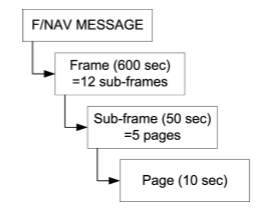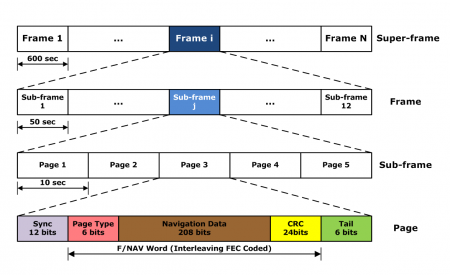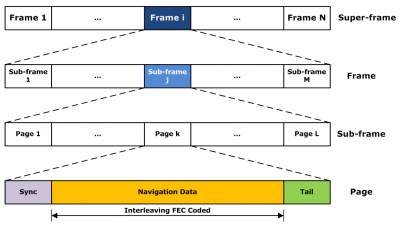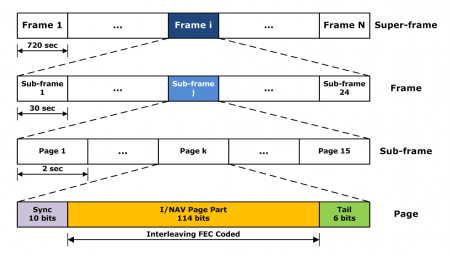If you wish to contribute or participate in the discussions about articles you are invited to contact the Editor
Galileo Navigation Message
| Fundamentals | |
|---|---|
| Title | Galileo Navigation Message |
| Author(s) | J. Sanz Subirana, JM. Juan Zornoza and M. Hernandez-Pajares, University of Catalunia, Spain. |
| Level | Basic |
| Year of Publication | 2011 |
The Galileo satellites broadcast different types of data in four navigation messages: the F/NAV navigatio, the I/NAV navigation message, the Commercial Navigation Message (C/NAV) and the Governmental Navigation Message (G/NAV).
The G/NAV navigation message does not belong to the public domain and the C/NAV is not yet defined. Please note that the formerly Commercial Service is now known as High Accuracy Service.
The details of the Galileo Signal Status are provided in the Galileo OS SIS Interface Control Document. [1] No other ICD documents have been published to date.
General Structure and Contents
The Galileo Signal-In-Space data channels transmit different messages type according to the general contents identified in the following table. The F/NAV types of message correspond to the OS and the I/NAV types of messages correspond to both OS and CS (current High Accuracy Service). The following table indicates the signal component associated to each navigation message type.

The complete navigation message data are transmitted on each data component as a sequence of frames. A frame is composed of several sub-frames, and each sub-frame is composed of several pages. The page is the basic structure for building the navigation message.
All data values encoded using the following bit and byte ordering criteria:
- For numbering, the most significant bit/byte is numbered as bit/byte 0.
- For bit/byte ordering, the most significant bit/byte is transmitted first.
According with the current published [Galileo SIS ICD, 2010] [1] both F/NAV and I/NAV navigation messages are called super-frame and broadcast as a sequence of frames that are composed of several sub-frames which in turn is composed by several pages.
The general structure of the navigation messages are common but the number of sub-frames and pages as well as the duration of each page are not the same, as represented in the following table.
| Message | Channel | Data rate (bps) | Page Duration (s) | Pages in a sub-frame | Sub-frames in a frame |
|---|---|---|---|---|---|
| F/NAV | E5a-I | 25 | 10 | 5 | 12 |
| I/NAV | E1B, E5b-I | 125 | 2 | 15 | 24 |
This arrangement allows accomplishing the three different main categories of data to be transmitted at different rates:
- Fast rate (for urgent data, such as integrity): page.
- Medium rate (Ephemeris, Clock Correction, ...): sub-frame.
- Slow rates (Almanacs): frame.
The page starts with a Synchronisation Word (SW) followed by the interleaving FEC (Forward Error Correction) coded navigation data and ends with tail bits for the FEC decoding. In addition both navigation messages transmit a CRC data field in order to detect corrupted data. The size of this field is different in each navigation message. Three levels of error coding are applied to the Galileo Message Data Stream:
- A Cyclic Redundancy Check (CRC) with error detection capabilities after recovery of the received data;
- A one-half rate Forward Error Correction (FEC). Tail Bits (sequence of zeros) to allow Viterbi decoding;
- Block Interleaving on the resulting frames: provides robustness to the FEC decoding algorithm since in presence of a burst of erroneous bits it is converted into small errors in several pages. This scheme allows reducing the bit error ratio in the increased data rates.
As referred, the FEC coded symbols are transmitted interleaved within the page and because of that the navigation data can only be decoded when the complete interleaving FEC coded part is received.
The following table summarizes the parameters transmitted by FNAV and INAV messages.
As can be seen in the table above, the parameters transmitted in F/NAV and I/NAV have the same size except for signal and message specific parameters, such as "Issue of Data (IOD)" and "Navigation Data Validity and Signal Health Status". In the case of "Satellite Almanac" set, the size is also different because the set includes the "Satellite signal health status". The Galileo ephemeris parameters are Keplerian-like orbital elements as in GPS. The nominal period update is 3 hours, being valid for a 4 hours time interval. The 1-hour overlap interval is intended to help against short outages or delays. The Galileo Almanac is also similar to the GPS and GLONASS ones.
F/NAV Structure
The F/NAV navigation message is transmitted on channel E5a-I at a rate of 25 bps. The F/NAV message structure is shown in the following figure, where the duration of each entity is indicated.

As represented in table 2 the F/NAV navigation message is transmitted on channel E5a-I at a rate of 25 bps according with the following structure.

Each frame of the F/NAV message has a duration of 600 seconds and it is composed by 12 sub-frames. In turn, each sub-frame has a duration of 50 seconds and it is composed by 5 pages with a duration of 10 seconds. The page itself comprises 3 main fields:
- Synchronisation pattern: has a length of 12 bits and is always 101101110000 being its purpose to allow the receiver to achieve synchronisation to the page boundary;
- F/NAV word: has a length of 238 bits and it is the interleaved and FEC encoded part of the page that encodes the fields: Page Type, Navigation Data and CRC.
- Tail: has a length of 6 bits and consists of 6 zero-values that are used to enable the completion of the FEC decoding of each page.
The Page Type field identifies the broadcast page which allows the user-receivers to react accordingly and grants the possibility of changing the pages sequencing, while keeping backward compatibility. The CRC is used as the most inner mechanism of errors detection because it is computed only on the Page Type and Navigation Data fields.
I/NAV Structure
The I/NAV navigation message is transmitted on both E1B and E5b-I channels at a rate of 125 bps. The two versions of the I/NAV message are disseminated through the same structure being its content also the same but not aligned over the time.
Each frame of the I/NAV message has a duration of 720 seconds and it is composed by 24 sub-frames. In turn, each sub-frame has a duration of 30 seconds and it is composed by 15 pages with a duration of 2 seconds. The page itself is composed by 3 fields:
- Synchronisation pattern: has a length of 10 bits and is always 0101100000 being its purpose to allow the receiver to achieve synchronisation to the page boundary;
- I/NAV page part: has a length of 114 bits and it is the interleaved FEC encoded part of the page where the navigation data is conveyed.
- Tail: has a length of 6 bits and consists of 6 zero-value bits that are used to enable the completion of the FEC decoding of each page part.
The page part of the message can be even or odd and both parts are always broadcast one after the other. In channel E1B the even part is transmitted first while in channel E5b-I the even part is transmitted after. The combination of two page parts constitutes a valid set of data (Nominal Page) that has to be parsed together to get the Navigation Data. The advantage of this configuration is that a receiver decoding the I/NAV on both frequencies can decode the same pages in half the time of a single frequency receiver.
Notes
References
- Hofmann-Wellenhof, B., Lichtenegger, H., K. and Wasle, E., 2008. GNSS - Global Navigation Satellite Systems. Springer-Verlag, Wien, Austria.
- Powe, M., 2006. Introduction to Galileo. powerpoint presentation, progeny.



